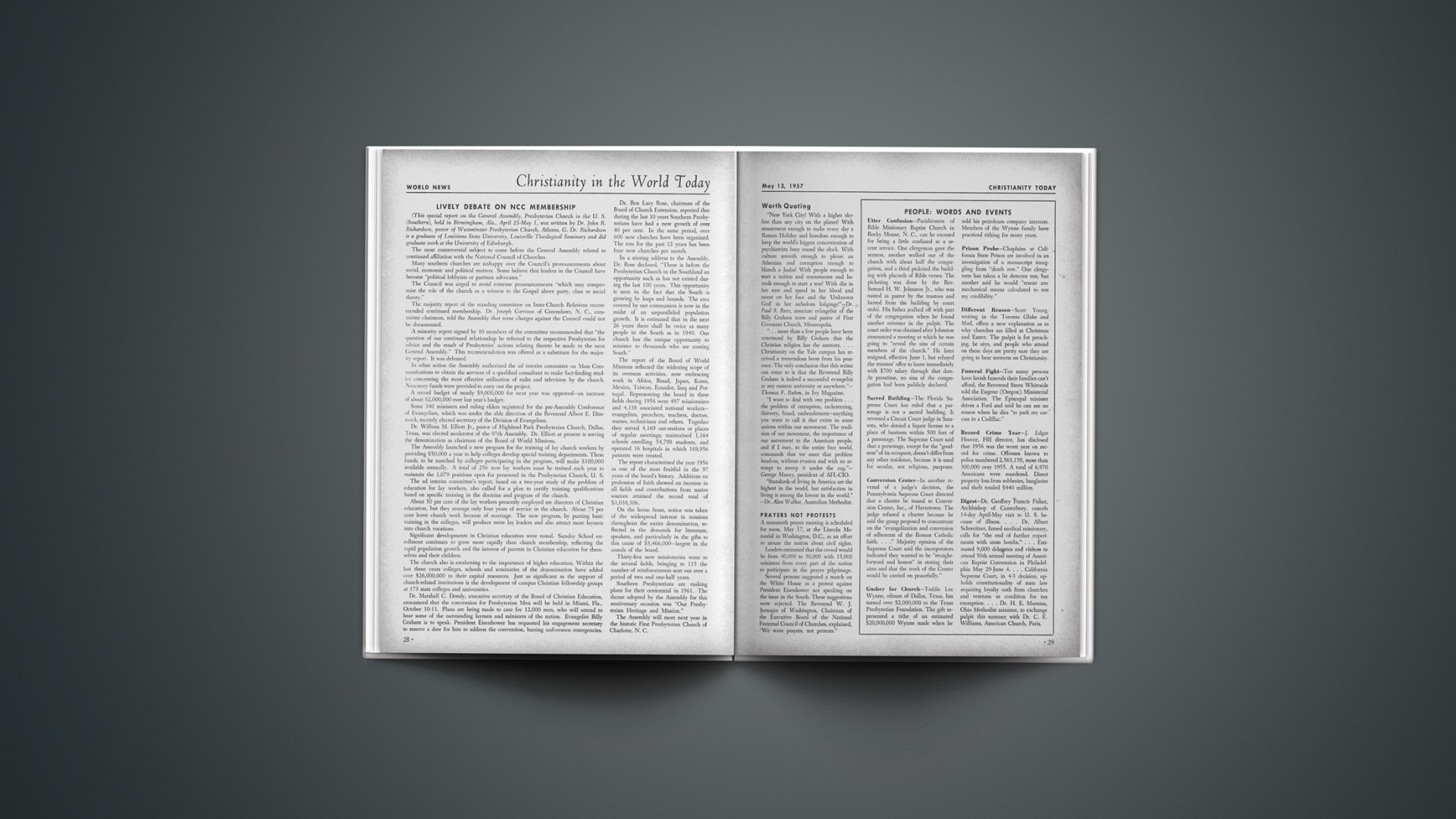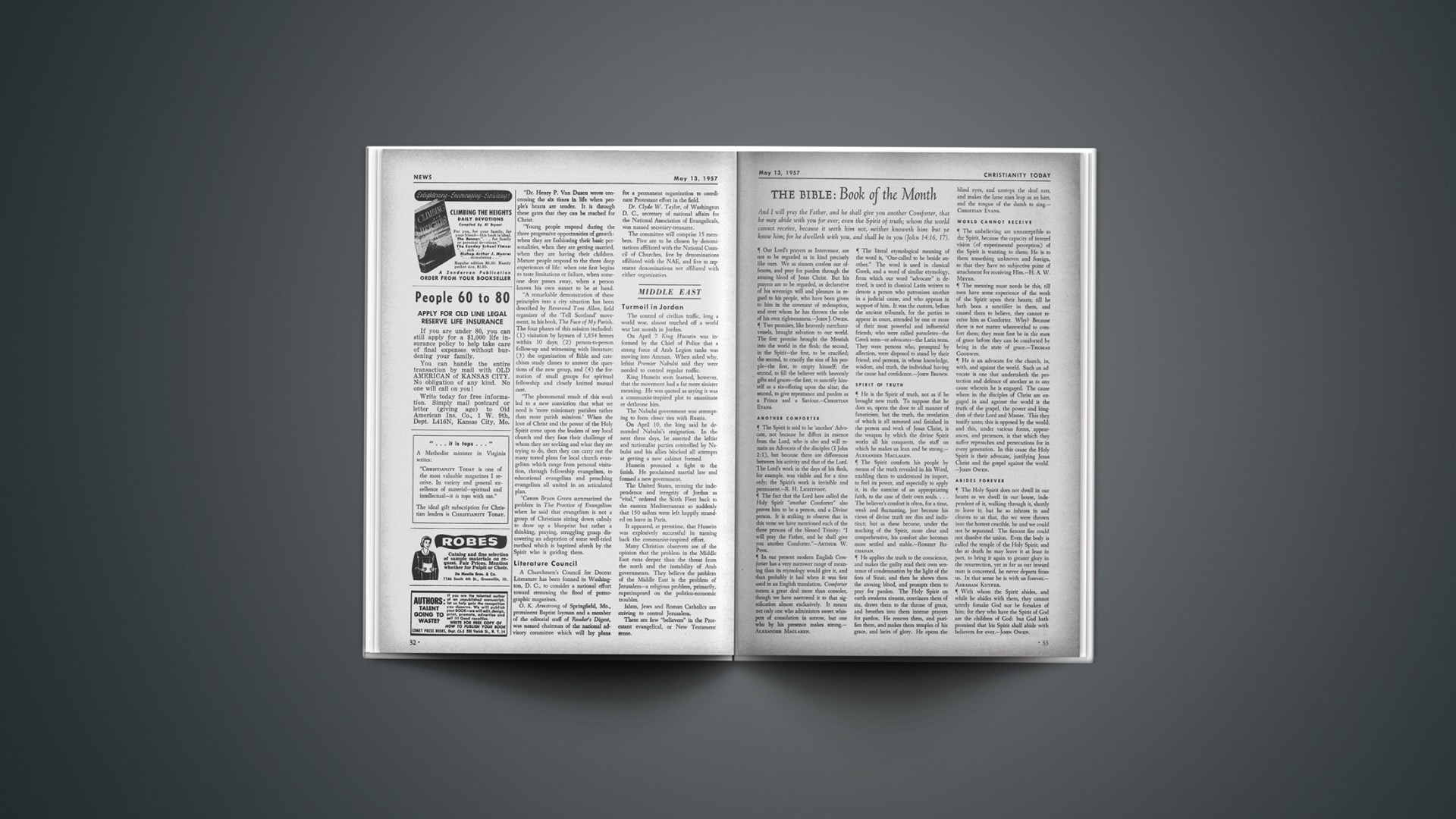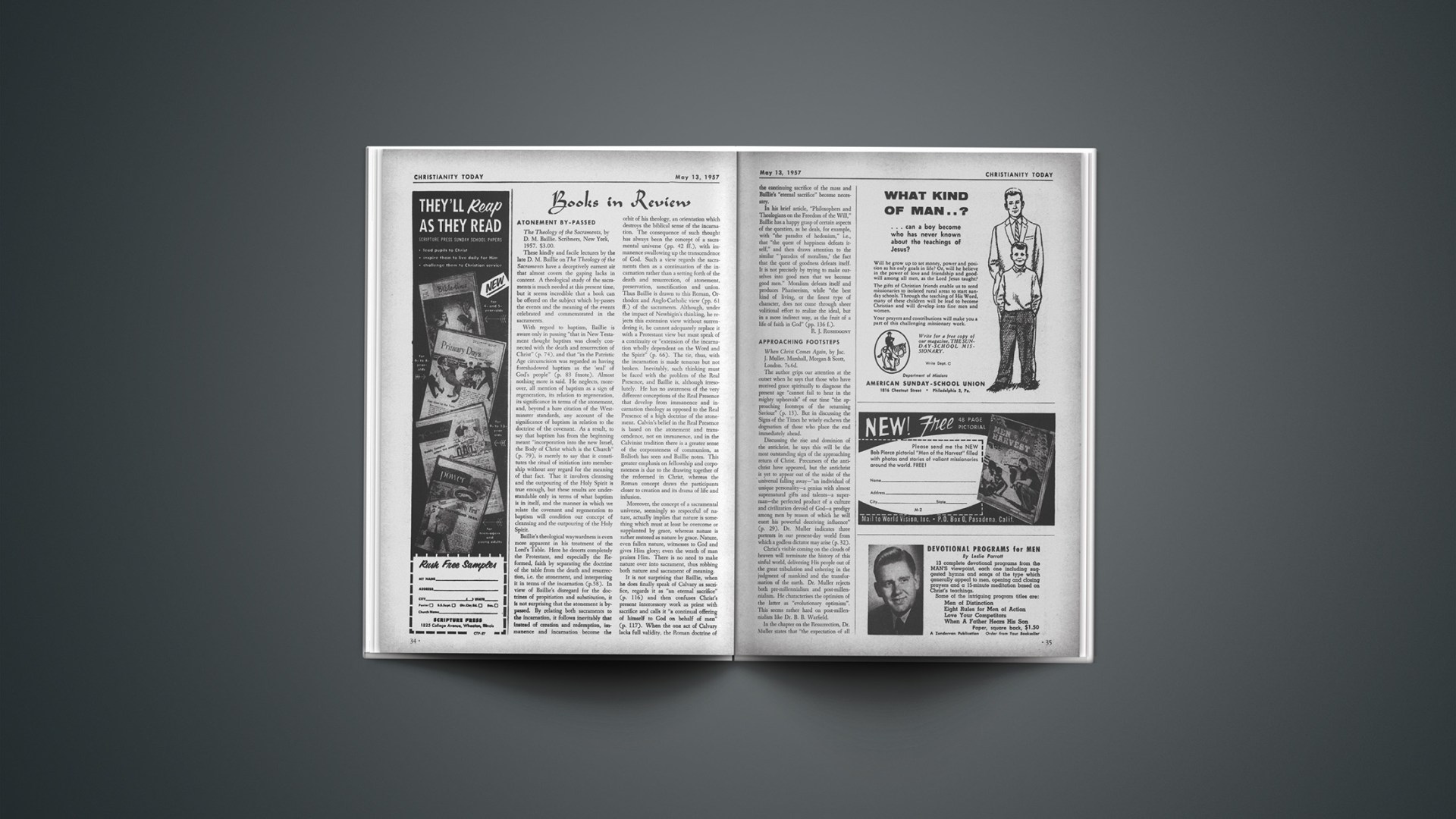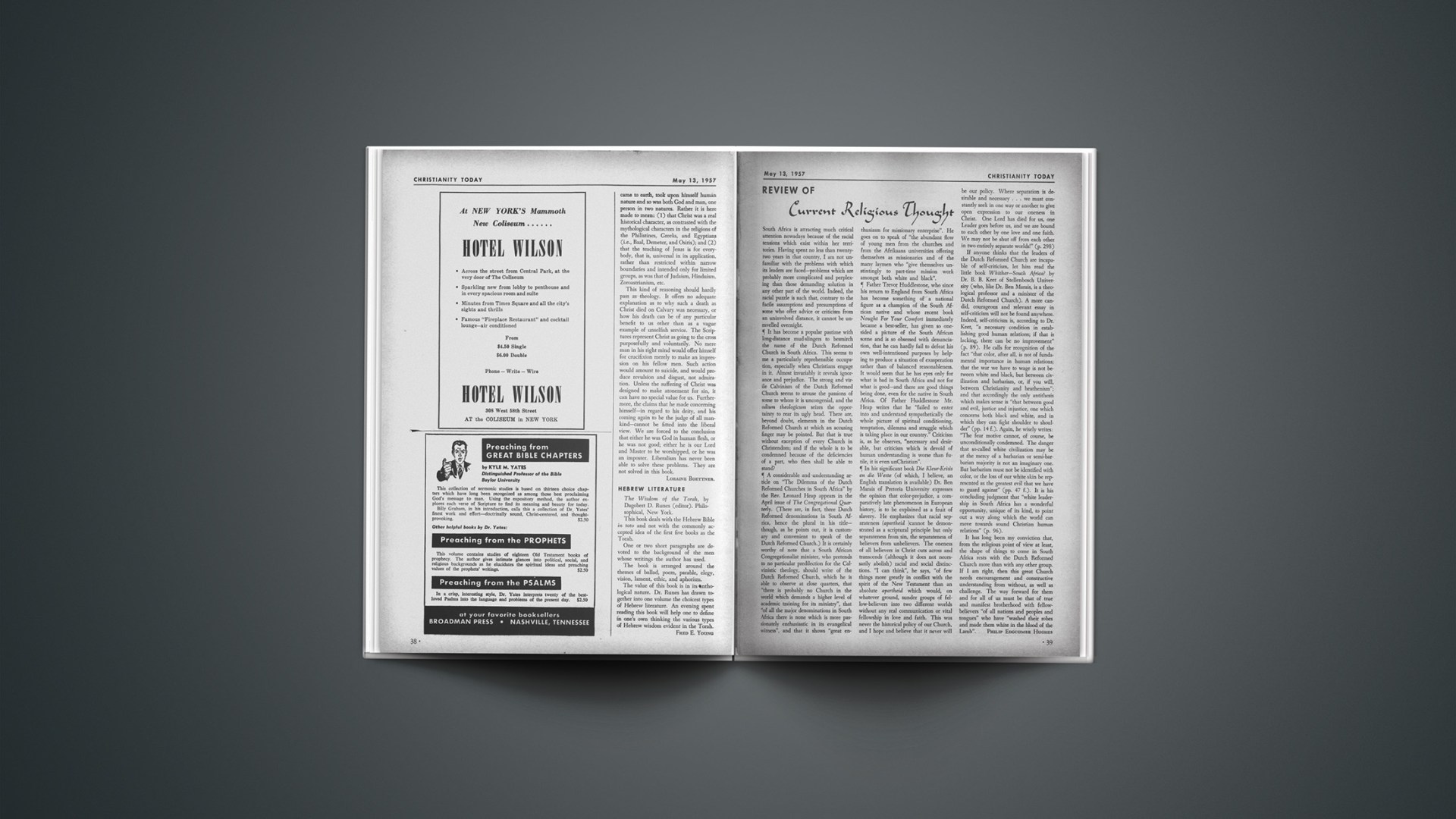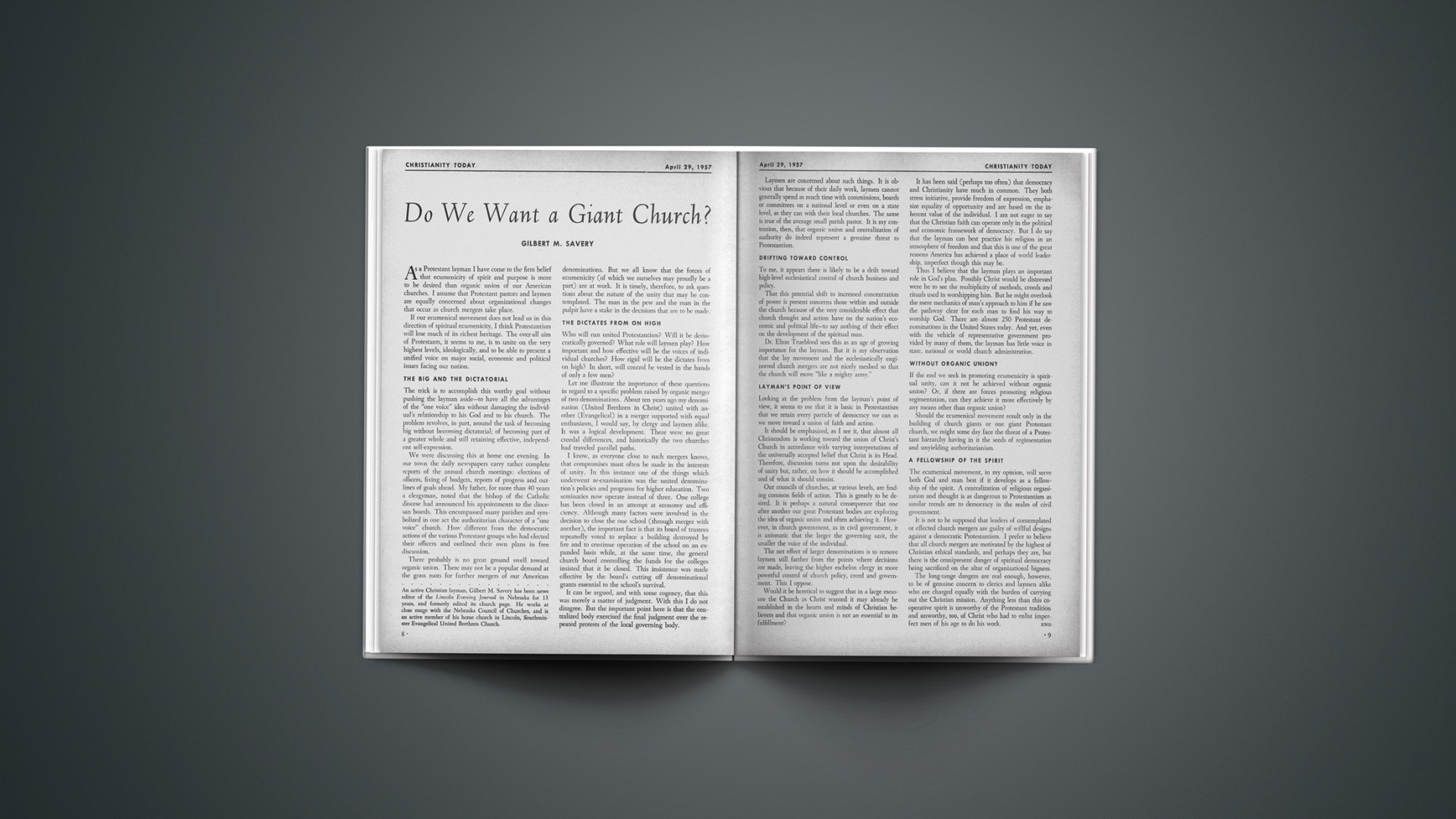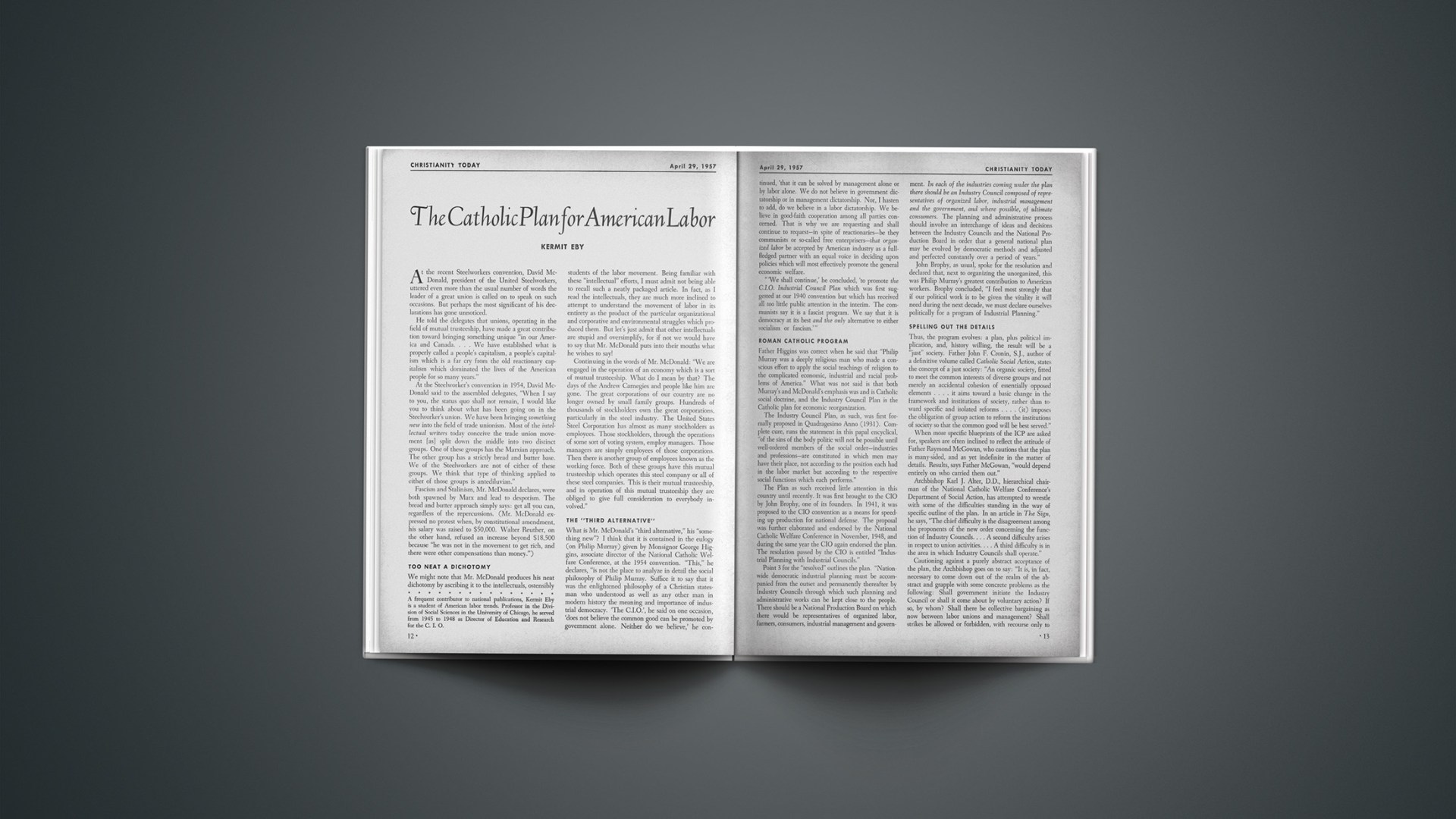WORLD NEWS
Christianity in the World Today
(This special report on the General Assembly, Presbyterian Church in the U. S. (Southern), held in Birmingham, Ala., April 25-May 1, was written by Dr. John R. Richardson, pastor of Westminster Presbyterian Church, Atlanta, G. Dr. Richardson is a graduate of Louisiana State University, Louisville Theological Seminary and did graduate work at the University of Edinburgh.
The most controversial subject to come before the General Assembly related to continued affiliation with the National Council of Churches.
Many southern churches are unhappy over the Council’s pronouncements about social, economic and political matters. Some believe that leaders in the Council have become “political lobbyists or partisan advocates.”
The Council was urged to avoid extreme pronouncements “which may compromise the role of the church as a witness to the Gospel above party, class or social theory.”
The majority report of the standing committee on Inter-Church Relations recommended continued membership. Dr. Joseph Garrison of Greensboro, N. C., committee chairman, told the Assembly that some charges against the Council could not be documented.
A minority report signed by 10 members of the committee recommended that “the question of our continued relationship be referred to the respective Presbyteries for advice and the result of Presbyteries’ actions relating thereto be made to the next General Assembly.” This recommendation was offered as a substitute for the majority report. It was defeated.
In other action the Assembly authorized the ad interim committee on Mass Communications to obtain the services of a qualified consultant to make fact-finding studies concerning the most effective utilization of radio and television by the church. Necessary funds were provided to carry out the project.
A record budget of nearly $9,000,000 for next year was approved—an increase of about $2,000,000 over last year’s budget.
Some 340 ministers and ruling elders registered for the pre-Assembly Conference of Evangelism, which was under the able direction of the Reverend Albert E. Dim-mock, recently elected secretary of the Division of Evangelism.
Dr. William M. Elliott Jr., pastor of Highland Park Presbyterian Church, Dallas, Texas, was elected moderator of the 97th Assembly. Dr. Elliott at present is serving the denomination as chairman of the Board of World Missions.
The Assembly launched a new program for the training of lay church workers by providing $50,000 a year to help colleges develop special training departments. These funds, to be matched by colleges participating in the program, will make $100,000 available annually. A total of 256 new lay workers must be trained each year to maintain the 1,079 positions open for personnel in the Presbyterian Church, U. S.
The ad interim committee’s report, based on a two-year study of the problem of education for lay workers, also called for a plan to certify training qualifications based on specific training in the doctrine and program of the church.
About 50 per cent of the lay workers presently employed are directors of Christian education, but they average only four years of service in the church. About 75 per cent leave church work because of marriage. The new program, by putting basic training in the colleges, will produce more lay leaders and also attract more laymen into church vocations.
Significant developments in Christian education were noted. Sunday School enrollment continues to grow more rapidly than church membership, reflecting the rapid population growth and the interest of parents in Christian education for themselves and their children.
The church also is awakening to the importance of higher education. Within the last three years colleges, schools and seminaries of the denomination have added over $26,000,000 to their capital resources. Just as significant as the support of church-related institutions is the development of campus Christian fellowship groups at 173 state colleges and universities.
Dr. Marshall C. Dendy, executive secretary of the Board of Christian Education, announced that the convention for Presbyterian Men will be held in Miami, Fla., October 10–13. Plans are being made to care for 12,000 men, who will attend to hear some of the outstanding laymen and ministers of the nation. Evangelist Billy Graham is to speak. President Eisenhower has requested his engagement secretary to reserve a date for him to address the convention, barring unforeseen emergencies.
Dr. Ben Lacy Rose, chairman of the Board of Church Extension, reported that during the last 10 years Southern Presbyterians have had a new growth of over 40 per cent. In the same period, over 600 new churches have been organized. The rate for the past 12 years has been four new churches per month.
In a stirring address to the Assembly, Dr. Rose declared, “There is before the Presbyterian Church in the Southland an opportunity such as has not existed during the last 100 years. This opportunity is seen in the fact that the South is growing by leaps and bounds. The area covered by our communion is now in the midst of an unparalleled population growth. It is estimated that in the next 26 years there shall be twice as many people in the South as in 1940. Our church has the unique opportunity to minister to thousands who are coming South.”
The report of the Board of World Missions reflected the widening scope of its overseas activities, now embracing work in Africa, Brazil, Japan, Korea, Mexico, Taiwan, Ecuador, Iraq and Portugal. Representing the board in these fields during 1956 were 497 missionaires and 4,138 associated national workers—evangelists, preachers, teachers, doctors, nurses, technicians and others. Together they served 4,169 out-stations or places of regular meetings; maintained 1,164 schools enrolling 54,798 students, and operated 16 hospitals in which 169,956 patients were treated.
The report characterized the year 1956 as one of the most fruitful in the 97 years of the board’s history. Additions on profession of faith showed an increase in all fields and contributions from native sources attained the record total of $1,038,306.
On the home front, notice was taken of the widespread interest in missions throughout the entire denomination, reflected in the demands for literature, speakers, and particularly in the gifts to this cause of $3,466,000—largest in the annals of the board.
Thirty-five new missionaries went to the several fields, bringing to 115 the number of reinforcements sent out over a period of two and one-half years.
Southern Presbyterians are making plans for their centennial in 1961. The theme adopted by the Assembly for this anniversary occasion was “Our Presbyterian Heritage and Mission.”
The Assembly will meet next year in the historic First Presbyterian Church of Charlotte, N. C.
Worth Quoting
“New York City! With a higher skyline than any city on the planet! With amusement enough to make every day a Roman Holiday and boredom enough to keep the world’s biggest concentration of psychiatrists busy round the clock. With culture smooth enough to please an Athenian and corruption enough to blanch a Judas! With people enough to start a nation and resentments and hatreds enough to start a war! With din in her ears and speed in her blood and sweat on her face and the ‘Unknown God’ in her nebulous longings!”—Dr. Paul S. Rees, associate evangelist of the Billy Graham team and pastor of First Covenant Church, Minneapolis.
“… more than a few people have been convinced by Billy Graham that the Christian religion has the answers.… Christianity on the Yale campus has received a tremendous boost from his presence. The only conclusion that this writer can come to is that the Reverend Billy Graham is indeed a successful evangelist at any eastern university or anywhere.”—Thomas F. Ruhm, in Ivy Magazine.
“I want to deal with one problem … the problem of corruption, racketeering, thievery, fraud, embezzlement—anything you want to call it that exists in some unions within our movement. The tradition of our movement, the importance of our movement to the American people, and if I may, to the entire free world, commands that we meet that problem head-on, without evasion and with no attempt to sweep it under the rug.”—George Meany, president of AFL-CIO.
“Standards of living in America are the highest in the world, but satisfaction in living is among the lowest in the world.”—Dr. Alan Walker, Australian Methodist.
Prayers Not Protests
A mammoth prayer meeting is scheduled for noon, May 17, at the Lincoln Memorial in Washington, D.C., as an effort to arouse the nation about civil rights.
Leaders estimated that the crowd would be from 40,000 to 50,000 with 15,000 ministers from every part of the nation to participate in the prayer pilgrimage.
Several persons suggested a march on the White House as a protest against President Eisenhower not speaking on the issue in the South. These suggestions were rejected. The Reverend W. J. Jernagin of Washington, Chairman of the Executive Board of the National Fraternal Council of Churches, explained, “We want prayers, not protests.”
The Social Ethic
“An idolatrous worship of organization” is developing in America, a secular magazine editor asserted in Philadelphia at the 38th annual meeting of The Associated Church Press (148 publications with circulation of 13,164,116).
William H. Whyte, Jr., assistant managing editor of Fortune and author of The Organization Man, labeled such a development “the social ethic.”
The editor said the social ethic is the primary motive today in choosing a career, joining a church, selecting a school or moving to the suburbs. He called it a fallacy to believe that “belongingness” is the primary need of man.
Instead of joining a church for a spiritual experience, the “organized man” joins it to identify himself with a social group and to have that group make decisions for him, Whyte said.
He continued:
“To some extent, the church itself is responsible for making the social ethic a quasi-religious drama. For some time the church has been sounding a note of community belongingness. In trying to drown out the call for rugged individualism, it has dropped its guard against the dangers of the social ethic.
‘Stimulating’
William B. Arthur, managing editor of Look Magazine, made the following remark in an address at the annual meeting of Associated Church Press:
“Among the ‘think’ periodicals, the new magazine CHRISTIANITY TODAY is the most stimulating.”
“It will be the people in the churches who will have to know when the time has come to make personal decisions and influence destiny. It is they who will have to determine the real moral issues involved in reinforcing the group organization by reducing the importance of the individual.”
In another convention address, Dr. Liston Pope, dean of Yale Divinity School, said the influence of religion on human affairs, in one of the world’s most critical moments, appears to be “indirect, immeasurable and, all told, rather minimal.”
“Even in the United States,” Dr. Pope said, “religious convictions make little discernible difference in American policies, though candidates for public office may refer piously to Almighty God in the closing paragraphs of their campaign speeches.”
He stressed that the extension of church membership through the general population “should not be allowed to obscure the present state of the world and its need for a redemptive gospel.”
In his talk, entided “Idols of the Intelligentsia,” Dr. Pope referred to “man-made cults” often cherished by supposedly educated and sophisticated persons—“indifference, objectivity, education, and even the great god ‘Reason,’ still dressed in his 18th century clothes.”
“Education,” he said, “is truly good,” but he asked: “Is education an adequate lamp unto our feet? Have not the best educated men been among the most forlorn? Have there not been many who moved from the exaltation of the university to the prostration of the psychiatrist’s couch?”
Delegates reaffirmed their opposition to the establishment of diplomatic relations between the United States and the Vatican.
Peter Day of Milwaukee, executive editor of The Living Church (Episcopal) was elected president of the organization. He succeeds Robert J. Cadigan of Philadelphia, editor of Presbyterian Life.
‘Danger To Faith’
In what must be considered one of the most complimentary denunciations on record, the director of the National Catholic Welfare Conference bureau of information declared that Billy Graham is “a danger to the faith of all Catholics who listen to him.”
The Rev. John E. Kelly of Washington, D. C., writing in the May issue of The Homiletic and Pastoral Review, a publication confined to Roman Catholic clergymen, warned Catholics against attending Graham’s New York Crusade, reading his published works and listening to his broadcasts.
He said, however, that both clerical and lay Catholics might “well imitate Billy’s dedication, zeal and organization in his preaching of Christianity to all who fall under the spell of his partial gospel.” He also asserted that for the unchurched “Billy will be a part-way guide to heaven.”
The Catholic priest lauded Graham as a “man of prayer, humble, dedicated and devout” and also praised him for giving to “many church-going Protestants a spiritual Bible-based message which they never or only seldom hear.” He described Graham’s teachings as “false” and “incomplete.”
The priest said he issued the warning because it had been estimated that Catholic attendance at the New York rallies would be “close to if not in the five-figure bracket.”
(The only other official Roman Catholic denunciation of a Graham campaign was made last year in the Philippines, where Catholics form a large majority. Observers credited the denunciation with boosting the crowd for a single service to 40,000. More than 5,000 responded when the invitation was given to accept Jesus Christ. This was the largest response during the world tour.)
Graham Articles
George Burnham, news editor of CHRISTIANITY TODAY, will write special articles for an estimated 800 secular newspapers and religious publications during the entire New York Crusade of Billy Graham.
Burnham, who has covered all foreign campaigns of the evangelist, will dispatch several articles each week, taking readers behind the scenes for warm, human interest events to supplement the regular press coverage.
Because of the importance of the crusade, the articles will be provided without cost, as a public service, by CHRISTIANITY TODAY. The Chattanooga News-Free Press began this service for major Graham campaigns two years ago, when Burnham was associated with the newspaper.
Church Evangelism
“With whom are we working?”
“For what are we laboring?”
These questions, described as essential in organizing a local church for evangelism, will be asked at a pre-General Assembly meeting of the Presbyterian Church, U. S. A., by Dr. Bryant M. Kirkland, pastor of First Presbyterian Church, Tulsa, Oklahoma.
In an address prepared for delivery at the assembly, to be held in Omaha, Nebraska, May 16–22, Dr. Kirkland says: “The answer to these questions explain why some churches are impotent.” He continues:
“The contemporary church needs to recognize afresh that it is working as a missionary community within a pagan society and secularist culture. The average church is now in a situation as comparable to that of a Christian group in Bangkok, surrounded by a dominant Buddhist culture. There are the common factors of modern facilities, relative ethics, urbane humanity, swift global communication and other universal characteristics typical of western life. Nevertheless when these are set aside, the church both in Bangkok or Boston must make its distinctive witness to the living Christ who is Saviour and Lord of all who believe. We have lost this radical thrust of Christianity into the non-Christian aspects of American life.
“Because this condition has continued, the church has another important evangelistic goal within its own membership. People formerly joined the church after they were converted. Now a high percentage join with the hope that they will be converted.
“Periodically the Church goes through this ‘half-way covenant’ stage as it did in colonial New England. Social pressures then coerced unregenerate members into the Church with the result that standards had to be relaxed for their comfort. The present popularity of the Church in our secular culture has caused the same condition. As a result there is as wide an evangelistic field within the ranges of most local churches as there is in the general community without.
“The Presbyterian New Life Handbook says, ‘There is now an impatience with a half-realized consciousness of Christ and a half-forgotten mission of the Church. There is an eager desire for a more radical and primitive Christianity.’
“The Church is called upon to distinguish early that joy of surrender to Christ is radically different from the desperate lostness of modern man, no matter how amiable he may be. When the local church senses the desolation of the lost and realizes there is a vast difference between Christianity and secularism filled with amenities, then the local programs of evangelism will be strongly motivated to overcome inertia.
“The key to successful employment of available programs of local evangelism is a ‘situational’ knowledge of individual people. Once the major assumptions above have been assimilated, it becomes a process of witnessing about the new life in Christ by individuals to individuals.
Night Of Prayer
Scores of churches across America will hold all-night prayer meetings on Wednesday, May 15, to support the opening of Billy Graham’s Crusade in New York’s Madison Square Garden.
The Rev. Armin Gesswein, coordinator for national prayer support through the National Association of Evangelicals, said a night of prayer is planned for at least one central point in each of the 10 major districts of the New York area on Tuesday, May 14.
“Dr. Henry P. Van Dusen wrote concerning the six times in life when people’s hearts are tender. It is through these gates that they can be reached for Christ.
“Young people respond during the three progressive opportunities of growth: when they are fashioning their basic personalities, when they are getting married, when they are having their children. Mature people respond to the three deep experiences of life: when one first begins to taste limitations or failure, when someone dear passes away, when a person knows his own sunset to be at hand.
“A remarkable demonstration of these principles into a city situation has been described by Reverend Tom Allan, field organizer of the ‘Tell Scotland’ movement, in his book, The Face of My Parish. The four phases of this mission included: (1) visitation by laymen of 1,854 homes within 10 days; (2) person-to-person follow-up and witnessing with literature; (3) the organization of Bible and catechism study classes to answer the questions of the new group, and (4) the formation of small groups for spiritual fellowship and closely knitted mutual care.
“The phenomenal result of this work led to a new conviction that what we need is ‘more missionary parishes rather than more parish missions.’ When the love of Christ and the power of the Holy Spirit come upon the leaders of any local church and they face their challenge of whom they are seeking and what they are trying to do, then they can carry out the many tested plans for local church evangelism which range from personal visitation, through fellowship evangelism, to educational evangelism and preaching evangelism all united in an articulated plan.
“Canon Bryan Green summarized the problem in The Practice of Evangelism when he said that evangelism is not a group of Christians sitting down calmly to draw up a blueprint but rather a thinking, praying, struggling group discovering an adaptation of some well-tried method which is baptized afresh by the Spirit who is guiding them.
Literature Council
A Churchmen’s Council for Decent Literature has been formed in Washington, D. C., to consider a national effort toward stemming the flood of pornographic magazines.
O. K. Armstrong of Springfield, Mo., prominent Baptist layman and a member of the editorial staff of Reader’s Digest, was named chairman of the national advisory committee which will lay plans for a permanent organization to coordinate Protestant effort in the field.
Dr. Clyde W. Taylor, of Washington D. C., secretary of national affairs for the National Association of Evangelicals, was named secretary-treasurer.
The committee will comprise 15 members. Five are to be chosen by denominations affiliated with the National Council of Churches, five by denominations affiliated with the NAE, and five to represent denominations not affiliated with either organization.
Middle East
Turmoil In Jordan
The control of civilian traffic, long a world woe, almost touched off a world war last month in Jordan.
On April 7 King Hussein was informed by the Chief of Police that a strong force of Arab Legion tanks was moving into Amman. When asked why, leftist Premier Nabulsi said they were needed to control regular traffic.
King Hussein soon learned, however, that the movement had a far more sinister meaning. He was quoted as saying it was a communist-inspired plot to assassinate or dethrone him.
The Nabulsi government was attempting to form closer ties with Russia.
On April 10, the king said he demanded Nabulsi’s resignation. In the next three days, he asserted the leftist and nationalist parties controlled by Nabulsi and his allies blocked all attempts at getting a new cabinet formed.
Hussein promised a fight to the finish. He proclaimed martial law and formed a new government.
The United States, terming the independence and integrity of Jordan as “vital,” ordered the Sixth Fleet back to the eastern Mediterranean so suddenly that 150 sailors were left happily stranded on leave in Paris.
It appeared, at presstime, that Hussein was explosively successful in turning back the communist-inspired effort.
Many Christian observers are of the opinion that the problem in the Middle East runs deeper than the threat from the north and the instability of Arab governments. They believe the problem of the Middle East is the problem of Jerusalem—a religious problem, primarily, superimposed on the politico-economic troubles.
Islam, Jews and Roman Catholics are striving to control Jerusalem.
There are few “believers” in the Protestant evangelical, or New Testament sense.
People: Words And Events
Utter Confusion—Parishioners of Bible Missionary Baptist Church in Rocky Mount, N. C., can be excused for being a little confused at a recent service. One clergyman gave the sermon, another walked out of the church with about half the congregation, and a third picketed the building with placards of Bible verses. The picketing was done by the Rev. Samuel H. W. Johnston Jr., who was ousted as pastor by the trustees and barred from the building by court order. His father walked off with part of the congregation when he found another minister in the pulpit. The court order was obtained after Johnston announced a meeting at which he was going to “reveal the sins of certain members of the church.” He later resigned, effective June 1, but refused the trustees’ offer to leave immediately with $700 salary through that date. At presstime, no sins of the congregation had been publicly declared.
Sacred Building—The Florida Supreme Court has ruled that a parsonage is not a sacred building. It reversed a Circuit Court judge in Sarasota, who denied a liquor license to a place of business within 500 feet of a parsonage. The Supreme Court said that a parsonage, except for the “goodness” of its occupant, doesn’t differ from any other residence, because it is used for secular, not religious, purposes.
Conversion Center—In another reversal of a judge’s decision, the Pennsylvania Supreme Court directed that a charter be issued to Conversion Center, Inc., of Havertown. The judge refused a charter because he said the group proposed to concentrate on the “evangelization and conversion of adherents of the Roman Catholic faith.…” Majority opinion of the Supreme Court said the incorporators indicated they wanted to be “straightforward and honest” in stating their aims and that the work of the Center would be carried on peacefully.”
Gusher for Church—Toddie Lee Wynne, oilman of Dallas, Texas, has turned over $2,000,000 to the Texas Presbyterian Foundation. The gift represented a tithe of an estimated $20,000,000 Wynne made when he sold his petroleum company interests. Members of the Wynne family have practiced tithing for many years.
Prison Probe—Chaplains at California State Prison are involved in an investigation of a manuscript smuggling from “death row.” One clergymen has taken a lie detector test, but another said he would “resent any mechanical means calculated to test my credibility.”
Different Reason—Scott Young, writing in the Toronto Globe and Mail, offers a new explanation as to why churches are filled at Christmas and Easter. The pulpit is for preaching, he says, and people who attend on these days are pretty sure they are going to hear sermons on Christianity.
Funeral Fight—Too many persons have lavish funerals their families can’t afford, the Reverend Steen Whiteside told the Eugene (Oregon) Ministerial Association. The Episcopal minister drives a Ford and said he can see no reason when he dies “to park my carcass in a Cadillac.”
Record Crime Year—J. Edgar Hoover, FBI director, has disclosed that 1956 was the worst year on record for crime. Offenses known to police numbered 2,563,150, more than 300,000 over 1955. A total of 6,970 Americans were murdered. Direct property loss from robberies, burglaries and theft totaled $440 million.
Digest—Dr. Geoffrey Francis Fisher, Archbishop of Canterbury, cancels 14-day April–May visit to U. S. because of illness.… Dr. Albert Schweitzer, famed medical missionary, calls for “the end of further experiments with atom bombs.” … Estimated 9,000 delegates and visitors to attend 50th annual meeting of American Baptist Convention in Philadelphia May 29–June 4.… California Supreme Court, in 4–3 decision, upholds constitutionality of state law requiring loyalty oath from churches and veterans as condition for tax exemption.… Dr. H. E. Mumma, Ohio Methodist minister, to exchange pulpit this summer with Dr. C. E. Williams, American Church, Paris.

